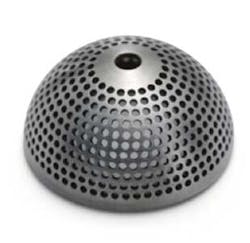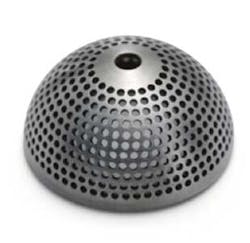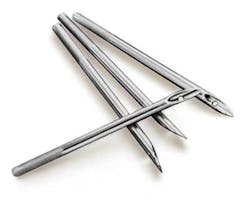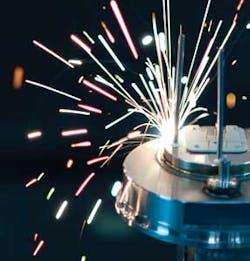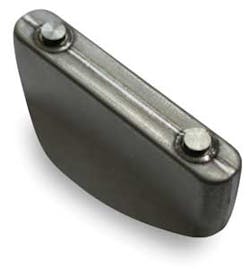Advances in processing medical devices
Mark Barry
Traditional machining techniques, some centuries old, are still useful in the manufacture of surgical, orthopedic, and other medical devices. However, recent advances in laser source and control technology are opening up new possibilities for the precision trimming, drilling, and heat treating of these critical products. When merged with additive manufacturing processes, designers can now have a "clean slate" as they approach design for manufacturability decisions. The following will give the reader an overview of the old and new and how they are being joined to advance the special needs of medical manufacturing.
Historical challenges
In 1957, a wearable transistorized cardiac pacemaker was introduced by Earl Bakken working in collaboration with renowned heart surgeon Dr. C. Walton Lillehei of the University of Minnesota. This was the beginning of the enormous global industry of manufacturing implantable devices that has revolutionized medicine.
Since the beginning, proper device function, biocompatibility, manufacturability and finally cost have been major problems. For a prosthesis implanted in a body to function properly and exist in harmony with tissue was a constant challenge. Designs have evolved over the years aided by advancements in microprocessing capability. Material choices made this compatibility problem less daunting.
Due to the extreme pressure to produce consistent and reliable lifesaving products, manufacturing engineers have designed unique solutions backed by statistical process control techniques that help insure processes that are under control and products that are reliable. This leaves us with cost issues. It will not benefit our society to have products that cannot be made affordable to the majority of people that require them.
Unfortunately for Earl Bakken, the industrial laser was not available, and early designs and processes struggled to produce the components required with conventional materials and machine tools of the day. This began to change rapidly with the first use of carbon dioxide (CO2) and neodymium doped yttrium-aluminum garnet (Nd:YAG) lasers for material processing. By 1990, the majority of laser applications used for metallic medical device development and manufacturing came to rely on two laser types: CO2 and flashlamp pumped Nd:YAG lasers.
In the mid 1990s, modified Nd:YAG output lasers also found success in key processes of nonthermal material removal (ablation) and spot welding. More technically demanding ablation requirements often were attempted with the excimer laser family (often with 25 to 50 micron spot size and 0.2 to 0.4 micron wavelength), generally perceived as expensive but effective task-specific systems.
Finding the correct laser
What follows is a brief description of the four types of lasers available today for materials processing (cutting, drilling, and welding) in medical device manufacturing and some guidelines to aid in identifying the correct laser for a manufacturing process.
It is important to remember that a laser is only one component of a successful laser system, similar to the role of an engine in an automobile. Evaluation of laser-based manufacturing equipment for medical applications must consider not only the laser but also the other components, such as the motion system, system control, process sensors, and ancillary components.
We should begin by briefly discussing the four laser types: CO2, pulsed Nd:YAG, Yb fiber, and ultrashort pulse length, and three material processing applications common to medical manufacturing: cutting, drilling, and welding.
• CO2 laser: A laser beam is produced by electrical excitation of a mixture of carbon dioxide, nitrogen, and helium gases. This laser type was one of the earliest used in manufacturing with the first documented industrial application in the cutting and welding of titanium in 1966. The wavelength is in the far infrared (IR) at 10.6 µm.
• Nd:YAG laser: This laser was first produced by excitation of a neodymium doped YAG crystal by one or more high intensity flashlamps; later a diode laser bar was tried. The wavelength of this laser is in the near IR at 1.06 µm. Nd:YAG lasers in use today are primarily of the pulsed type; CW versions have been largely displaced by fiber lasers.
• Fiber laser: Produced by excitation of Yb (ytterbium) doped optical fiber using diode lasers. While there are other dopants possible, Yb is thought to be more cost effective for high power applications in material processing. The wavelength of this laser is also near IR at 1.07 µm. The output of fiber lasers can be both pulsed and continuous. This is the laser that should make engineers rethink the use of laser processing in manufacturing.
• Ultrashort pulse length laser: Generally defined as solid state pulsed laser sources with output pulse lengths of a few hundred picoseconds (10-12 seconds) to femtoseconds (10-15 seconds). These lasers typically have a fundamental wavelength. The fundamental frequency in the near IR at 1.06 µm is then often doubled, tripled, or possibly quadrupled to producing visible or UV wavelengths. There are advantages to processing with shorter wavelengths, such as when there is a need to focus the laser beam to a diameter smaller than can be achieved using the fundamental wavelength. The common feature of this type of laser is the ability to produce very high quality beams, with very short pulse lengths at high frequencies, typically in the hundreds of kHz up to MHz frequencies.
It is clear from the generally available materials as well as manufacturers' reports that two of the laser types, CO2 and Yb fiber, are more or less equally capable of cutting and welding thin and thick materials for medical devices. Ultrashort pulse length lasers are best used for cutting and drilling thin materials where there is a requirement for little or no heat affected zone (HAZ) and/or post-processing of the finished part.
Likewise, pulsed Nd:YAG is the only one that is capable of drilling high aspect ratio holes, although recent developments in high peak power fiber lasers are making them impossible to ignore. Intense studies are underway in the use of this type of laser for hole drilling. If the drilling of high aspect ratio holes becomes a requirement today, the only laser choice is a pulsed Nd:YAG. A variety of cutting and trimming applications is possible, but at lower speeds than could be achieved with the other laser types. There is the possibility for some autogenous welding, but welding with filler materials is generally beyond the capabilities of the typical pulsed Nd:YAG drilling laser.
Selecting a laser for a combination of cutting and welding is a relatively easy choice. Selecting a laser type for a combination of drilling and cutting, drilling and welding, or all three processes remains a more difficult process. This decision may result in a system that does not give a satisfactory solution to all the processing requirements.
Cutting
Laser cutting occurs when a focused laser beam melts material after being absorbed at the surface of the workpiece. An assist gas delivered normally co-axial to the focused laser beam is used to provide mechanical energy, and in some cases chemical energy, to remove the laser-melted material from the back side of the material. So called "clean cutting" can be used with many materials and involves an inert gas, such as nitrogen, argon, or helium, to create an edge that is chemically unreacted and relatively free from burrs and debris with a small HAZ. The latter depends upon the laser parameters, capability of the motion system, and workpiece geometry. With ultrashort picosecond (ps) and femtosecond (fs) pulse length lasers, assist gas is not required since material is removed by vaporization and/or sublimation, sometimes referred to as "cold ablation." Little heat is absorbed by the workpiece as a result of the combination of low energy, short pulse duration, and high repetition rates. The result is a cut edge characterized by a small, almost immeasurable HAZ.
Drilling
Percussion drilling. The laser beam is focused to a diameter approximately equal to the required hole diameter. The laser is focused onto the surface of the stationary material, and a series of laser pulses removes material by melt expulsion, until a hole is created through the material. A method of continuous hole production, referred to as drill-on-the-fly (DoF), is an extension of percussion drilling in which a component is rotated at a controlled speed while single laser pulses are applied to a series of hole locations. On subsequent rotations of the part, additional pulses are delivered to each hole location until the finished hole is created.
Percussion drilling and DoF rely on high energy per pulse at a pulse rate of tens of pulses per second. Each pulse melts a portion of the material to be removed, creating a high pressure within the melt cavity. This leads to the molten material being expelled in the form of droplets. The size of the droplets is dependent upon the specific laser parameters and material chemical composition.
Trepan drilling. The laser beam is focused to a diameter that is smaller than the required hole diameter. The material is pierced with a small pilot hole, usually in the center of the required hole diameter. A circular, orbiting motion is then applied to cut the hole to the required diameter.
Ablation. An ultrashort pulse length laser is used to progressively ablate material to form a blind or through hole. The laser focus diameter is typically small in relation to the required hole diameter. The beam is most often delivered to the workpiece by means of a scanner, which can be programmed to "raster" the laser focus at relatively high speed across material forming a shape, or in a circular or helical pattern to create round holes. Material is removed in layers until the required depth is reached or a through hole is formed. Assist gas is not used. This type of motion can produce features at high speed; however, the low energy of the laser pulses limits this method to thin materials and/or shallow ablation depths.
Trepan drilling provides a compromise between quality (roundness, taper, HAZ) and throughput (holes per second). Using DoF and ablation, holes can be produced at rates of more than 100 holes per second. However, the actual rate depends upon the depth, diameter, and quality requirements of the hole. Generally, high beam quality, millisecond pulse length Nd:YAG lasers have historically been chosen to provide a good balance of throughput and precision when producing holes in medical device components.
Welding
Laser welding falls into two categories:
• Autogenous welding is when materials are fused together without the addition of extra materials. This form of laser welding requires a high level of fixturing, accuracy of motion and joint preparation. It is essential the materials to be welded remain in a controlled contact during the welding process. Any variation of the materials can result in an unacceptable weld profile and/or a complete failure of the welded joint.
• Additive welding is where material is added to the weld, usually in the form of metallic wire or powder. When adding material, the joint fit-up becomes more tolerant. Acceptable welds may be produced from joints with less than perfect fit-up. The addition of wire or powder to the joint creates an extra control variable and careful consideration must be given before this choice of weld is used.
Laser welding most often requires the use of an inert shield gas to prevent oxidation. Shield gas delivery depends on the materials to be welded and the joint configuration. This ranges from a simple co-axial or an off-axis nozzle that produces a cloud of shield gas at the local area to complex shielding schemes that are plumbed into fixtures at critical points and controlled by the motion system controller. In its most complex form, this can be a completely inert, dry, oxygen free glove-box.
Conclusion
The choice of a laser source for any medical manufacturing application is now easier (because of the historical record) and at the same time more complex (more choices, new choices). Manufacturing engineers and management should not rely on past experience, old information and conclusions reached as short as five years ago.
Welding has continued to be one of the largest markets for lasers in medical device manufacturing. The applications are wide ranging, from pacemaker and battery case components to surgical device assembly to nonmetallic catheter components. The reduction in physical size, innovations in beam delivery, and increase in performance and flexibility of laser systems, particularly those based on the fiber laser, has brought more processes into medical device manufacturing while expanding the scope of how medical devices can be designed.
Cutting and drilling with a laser system is now often a first choice for many manufacturing operations because of smaller lot sizes, customization of designs, and improvements in quality of finishes and metallurgy. This will continue to expand as processing with fiber lasers is better understood and prices of the lasers themselves continue to decline.
The driving force behind new applications will always be the designers who press for new solutions to design challenges.
Mark Barry([email protected]) is vice president of sales and marketing for Prima Power Laserdyne LLC. Contributing to the article were Peter Thompson and Luca Bianchini, staff of Prima Power Laserdyne LLC.
The authors are in a unique position to comment for this article. Collectively they have spent more than 65 years in the industrial laser / material processing arena. Their company builds a variety of CO2 and Nd:YAG lasers, and their turnkey systems can be supplied with all of the laser types mentioned in this article. System costs have decreased for older accepted applications, control of process is greatly improved and the use of fiber lasers means that processes and designs that were cost prohibitive must now be reconsidered. This article contains their observations.
More Industrial Laser Solutions Current Issue Articles
More Industrial Laser Solutions Archives Issue Articles
